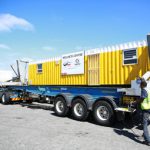Fuel-saving device to cut transport costs?

Hydroflex, a hydrogen-based fuel-reduction system said to cut fuel use by ten to 15 percent, while reducing the exhaust emissions of internal combustion engines, is undergoing final trials in South Australia ahead of its commercial launch.
Chief technology officer and inventor, Richard Connors, has been working on the device for a decade. He says that, unlike catalytic converters and diesel particulate filters that treat emissions after the fact, his device uses hydrogen and oxygen to increase the amount of fuel burnt during the combustion process.
“The device is cost effective and delivers value to the bottom line. At the same time, it reduces all seven types of pollution that normally come out of an exhaust pipe. We positively reduce all of them at different ratios,” Connors says.
The system can be fitted to any internal combustion diesel or petrol engine ranging in size from a car to a cruise ship. The device includes a 1,5-litre tank of water with an electrolyte in it. A small voltage of electricity is applied to the water to initiate electrolysis that creates hydrogen and oxygen vapour. The vapour is then piped through a standard rubber hose to the front of the air filter, where it is combined with normal air to produce a hydrogen-enhanced combustion process.
“The hydrogen and oxygen mix is not a fuel, it is an accelerant that moves the flame front faster, which means it burns more fuel and leads to more power and less pollution,” Connors says, adding that previous hydrogen systems relied on pressurised gas cylinders, needed operator intervention and had safety issues requiring certification.
The Hydroflex device has been vetted by government officials and does not need any special approvals before being fitted to an engine.
The company is initially focusing on large engines such as generators on mining sites, long-haul trucks, ships and diesel trains, because they represent the biggest opportunities in terms of fuel savings and emission reductions.
Independent testing will begin on generators for the mining industry and trucks for the transport industry in the coming weeks.
The company says the payback periods would average about 12 months for most engines. The reduction in carbon emissions could also make companies eligible for carbon credits. The device can be moved from one vehicle to another and updated as new versions are developed.
Hydroflex, formerly known as Hydrogen Power Systems, relocated from San Diego in the United States to the Tonsley Innovation Hub in the South Australian capital Adelaide, during April.
Published by
Focus on Transport
focusmagsa




